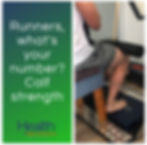Runners, what's your number? Calf strength
- Luke Nelson
- Aug 28, 2020
- 2 min read
Anyone following us for a while would know our love for the calf muscles (see here), and for good reason! The calf muscles, & to be more specific the soleus muscle, do a considerable amount of work during running.

From the work of Hamner & Schache, we know that the calf muscles combined are responsible for a large portion of the ground reaction force in the vertical direction (up to 75%, with the quads absorbing the remaining 25%), AND nearly ALL of the propulsive component of the ground reaction force in the anterior-posterior direction. Simply speaking, the calves are the muscles responsible for moving us forward, which is a pretty important thing for running!

From Dorn's 2012 study, we know the soleus takes in excess of 6 x bodyweight, and is the number 1 muscle at speeds below sprinting.

So it's not surprising that the soleus is one of our go-to muscles that we will test on our runners for any running-related injury. After all, if the calves aren't pulling their weight, then other areas will!
Using our state of the art AxIT system forceplates, we utilize the seated isometric calf to measure the strength of the soleus in addition to the standing calf isometric.
What is the ideal strength?
We like to see running athletes achieve a range between 1.5-2 x bodyweight for both these tests. This normative range is supported by Seth O'Neil's 2018 & 19 studies. So for a 70kg individual, this would equate to 105-140kg on both the seated & standing calf raise tests.

For all the runners out there, if you'd like to know your number, don't hesitate to contact us at www.healthhp.com.au
#whatsyournumber #calfstrain #achilles #calfstrength #achillestendinopathy #rehab #runninginjury #AxIT #strength #sportschiro #running #melbourne
References
Dorn, T. W., et al. (2012). "Muscular strategy shift in human running: dependence of running speed on hip and ankle muscle performance." J Exp Biol 215(Pt 11): 1944-1956.
Lenhart, R., et al. (2014). "Hip Muscle Loads During Running at Various Step Rates." J Orthop Sports Phys Ther: 1-30.
O'Neill, S., et al. (2018). "Acute sensory and motor response to 45-s heavy isometric holds for the plantar flexors in patients with Achilles tendinopathy." Knee Surg Sports Traumatol Arthrosc.
O'Neill, S., et al. (2019). "Plantarflexor strength and endurance deficits associated with mid-portion Achilles tendinopathy: The role of soleus." Physical Therapy in Sport 37: 69-76.
Schache, A. G., et al. (2014). "Lower-Limb Muscular Strategies for Increasing Running Speed." J Orthop Sports Phys Ther: 1-44
